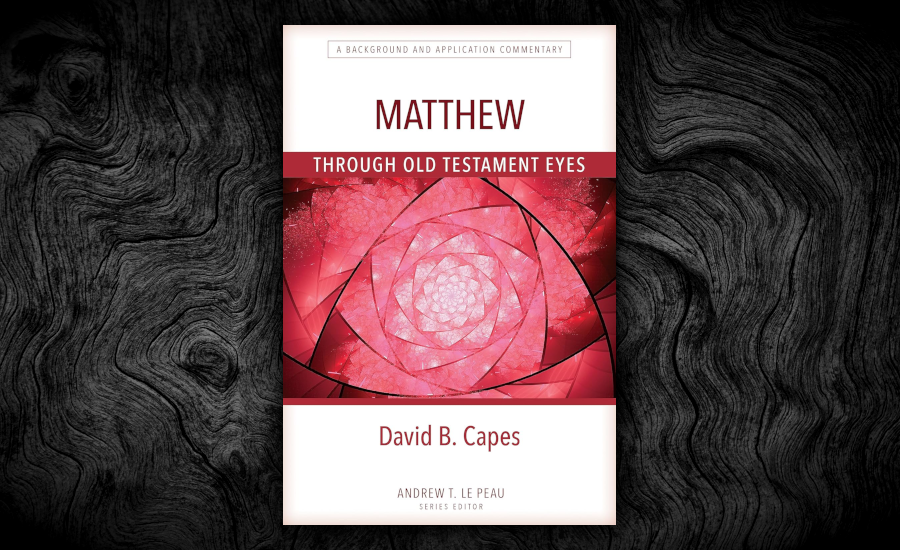Review of ‘Matthew Through Old Testament Eyes’ by David Capes
Image

Matthew Through Old Testament Eyes, Grand Rapids: Kregel, 2024, 389 pages, paperback.
I have already reviewed the previous volumes from this series. All three were what I would call average to above average works, containing useful content, although my repeated refrain was that in my opinion they fail to live up to the title. If you want to write a NT commentary “through OT Eyes” then you really can’t superimpose the NT on it. At least you can’t unless what you meant to say was something like “How the NT Book of _____ Reads the OT.”
David Capes has showed himself to be a careful and interesting scholar. I’m a little surprised to find him writing on the Gospel of Matthew instead of a Pauline book like Romans or Ephesians, but I have enjoyed his previous work so I wanted to read this one. And as a basic commentary on Matthew this one isn’t bad. Many bases are covered. Some light is shone on the text and its background. But it loses out to many superior works on this Gospel.
Unfortunately, Capes’ references to the OT are often merely instances of “this passage could not have been very far from Jesus’ thoughts,” which can be helpful, but at other times can be curious (e.g., Capes, 94, refers to Isa. 42:6 and 49:6 to illustrate Jesus’ “you are the light of the world” remark in Matt. 5:14-16; or on page 216, linking the faith of the woman in Matt. 15:28 to Isaiah 60:1-3). A lot of the time the OT reference seems fairly incidental, and is often not sufficiently developed by the author to benefit the interpretation. Many times it just seemed that Capes was trying to find an OT passage to relate to Matthew’s narrative. A good example of this is the comments on Matthew 11:28-30 which are at best pedestrian (174-175). This again is not what the title, Matthew Through Old Testament Eyes, would lead one to understand.
In some places the author strays from the point of the text to make a point. For instance, I could do without the moralistic admonition to make up for the social disadvantages of women (36). If there’s anything modern women in the West have it’s advantages. Capes claims the church is behind the culture. Good! The culture has feminized the West, told women that being a wife and mother is a bad thing, encouraged them to be promiscuous and career-driven and entitled, and poured scorn on the biblical commands for wives to respect and submit to their husbands. It is no surprise at all to discover that Capes worked at Wheaton, a veritable fountainhead of evangelical feminism and wokeness.
When it comes to some of the critical interpretive issues in the Gospel I was unimpressed by the commentary. Jesus words in Matthew 10:23 (“For assuredly, I say to you, you will not have gone through the cities of Israel before the Son of Man comes”) is dealt with too briefly and without any attention to the possibility of prolepsis, which to my mind is the best option (162). The comments on the parable of the leaven in Matthew 13:20 is summed up with “the kingdom of heaven infuses and influences the whole of the earth” (197). There is nothing about the symbolic use of leaven in Scripture. The interpretation is flat and banal.
Coming to the key text of Matthew 19:28 Capes believes the reference is to Isaiah 65 (251). But Isaiah 65 says absolutely nothing about a throne. First, if you are to set Isaiah 65:17ff in the New Heavens and Earth then you need to face Isaiah 65:20 head-on. That text cannot be fitted into the New Creation. Unfortunately, Capes completely fails to address the issues. Yes, I expected it, but I was still disappointed since this commentary claims to work on the premise of “Old Testament Eyes.” Where are the references to the OT Abrahamic and Davidic covenants and the expectations of national glory and salvation for Israel?
On his discussion of the Olivet Discourse Capes doesn’t even include the disciples’ questions in Matthew 24:3 (294)! Unsurprisingly, he believes the fulfillment of Jesus’ warning in Matthew 24:15-22 was A. D. 66-70 (298-299). Finally, citing Jennifer Rosner, he offers a bizarre possible alternative view of the people’s cry in Matthew 27:26, “His blood be upon us and on our children” as an ironic “unintentional prophecy of how they will be redeemed” (332).
I wanted to like this commentary, but I think it fails because it is neither a clear exegesis of Matthew’s narrative, nor is it a particularly compelling account of the way the OT prepares us to understand Matthew. Capes is a fine scholar, and his co-authored introduction to Paul is one of the very best, but sadly I cannot recommend his Matthew Through Old Testament Eyes. As with the rest of this series, you cannot tell readers what influence the OT had on NT authors if you insist on spiritualizing the OT while trying to persuade us that the NT does the same. I’m sorry, I don’t buy it.
Dr Reluctant Articles
Reposted from Dr. Reluctant.
Paul Henebury Bio
Paul Martin Henebury is a native of Manchester, England and a graduate of London Theological Seminary and Tyndale Theological Seminary (MDiv, PhD). He has been a Church-planter, pastor and a professor of Systematic Theology and Apologetics. He was also editor of the Conservative Theological Journal (later Journal of Dispensational Theology). He is now the President of Telos School of Theology.
- 133 views


Discussion